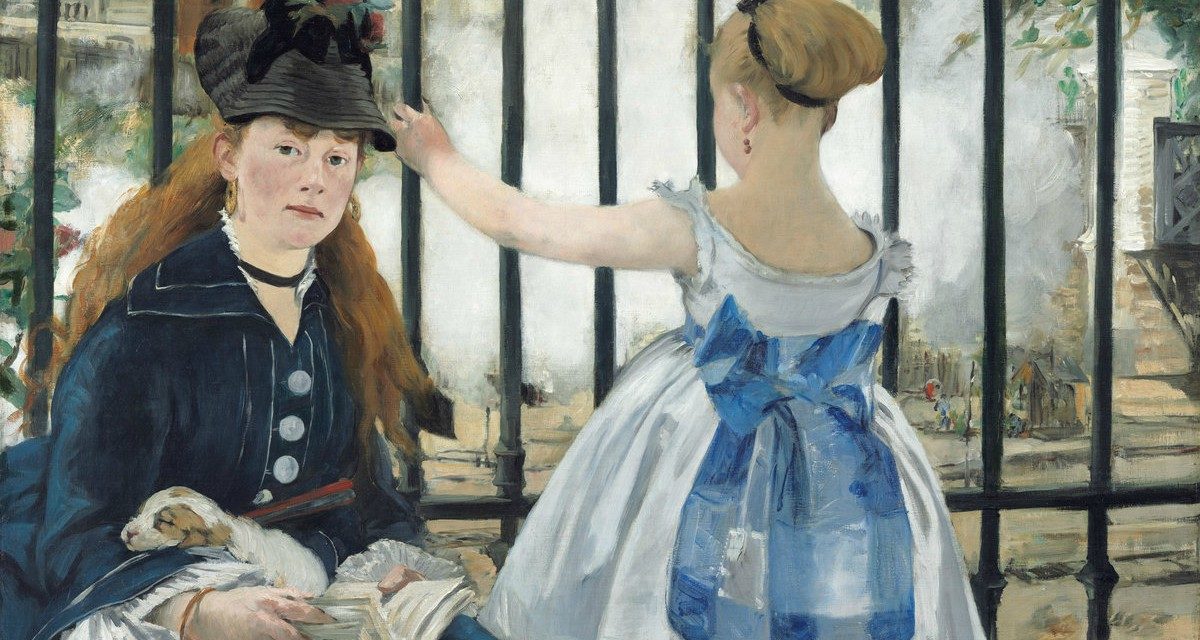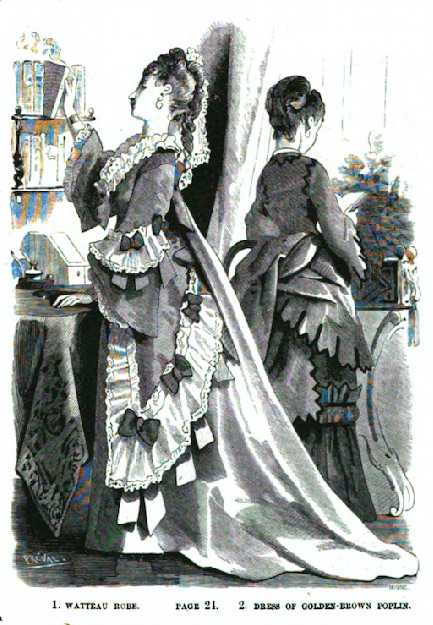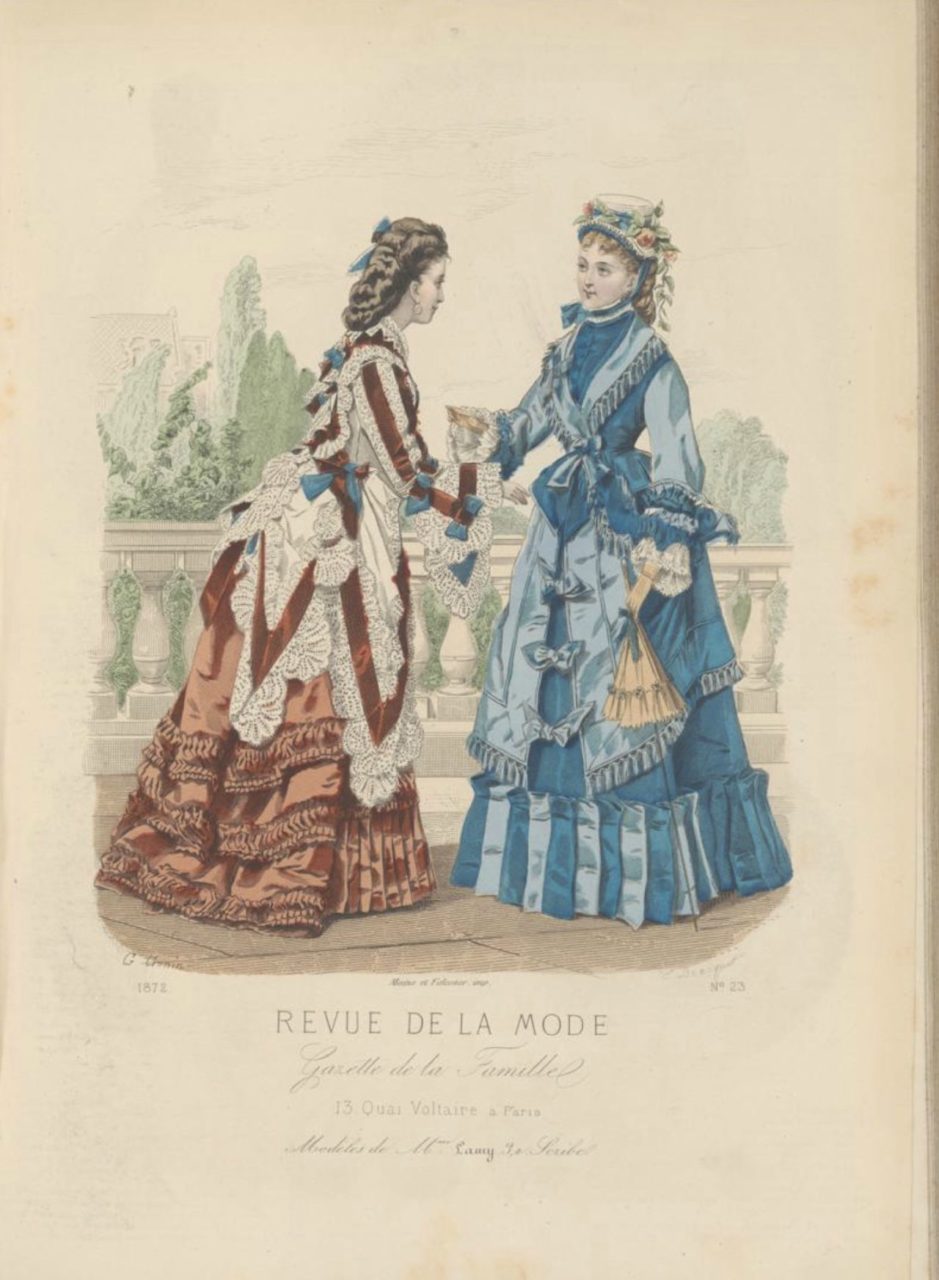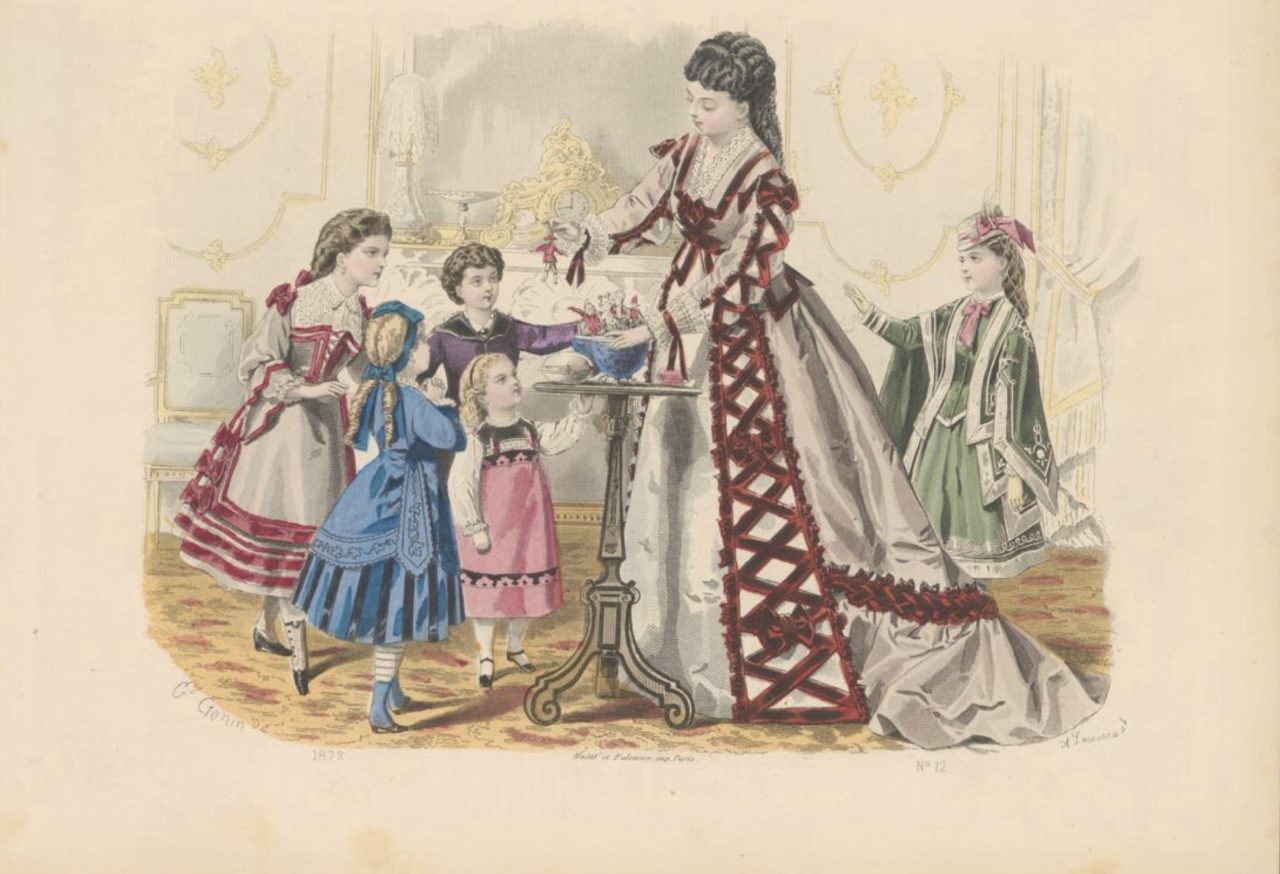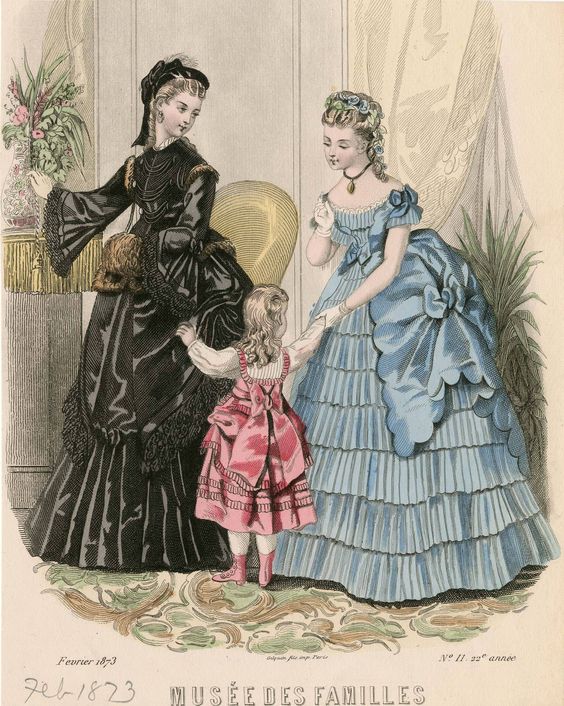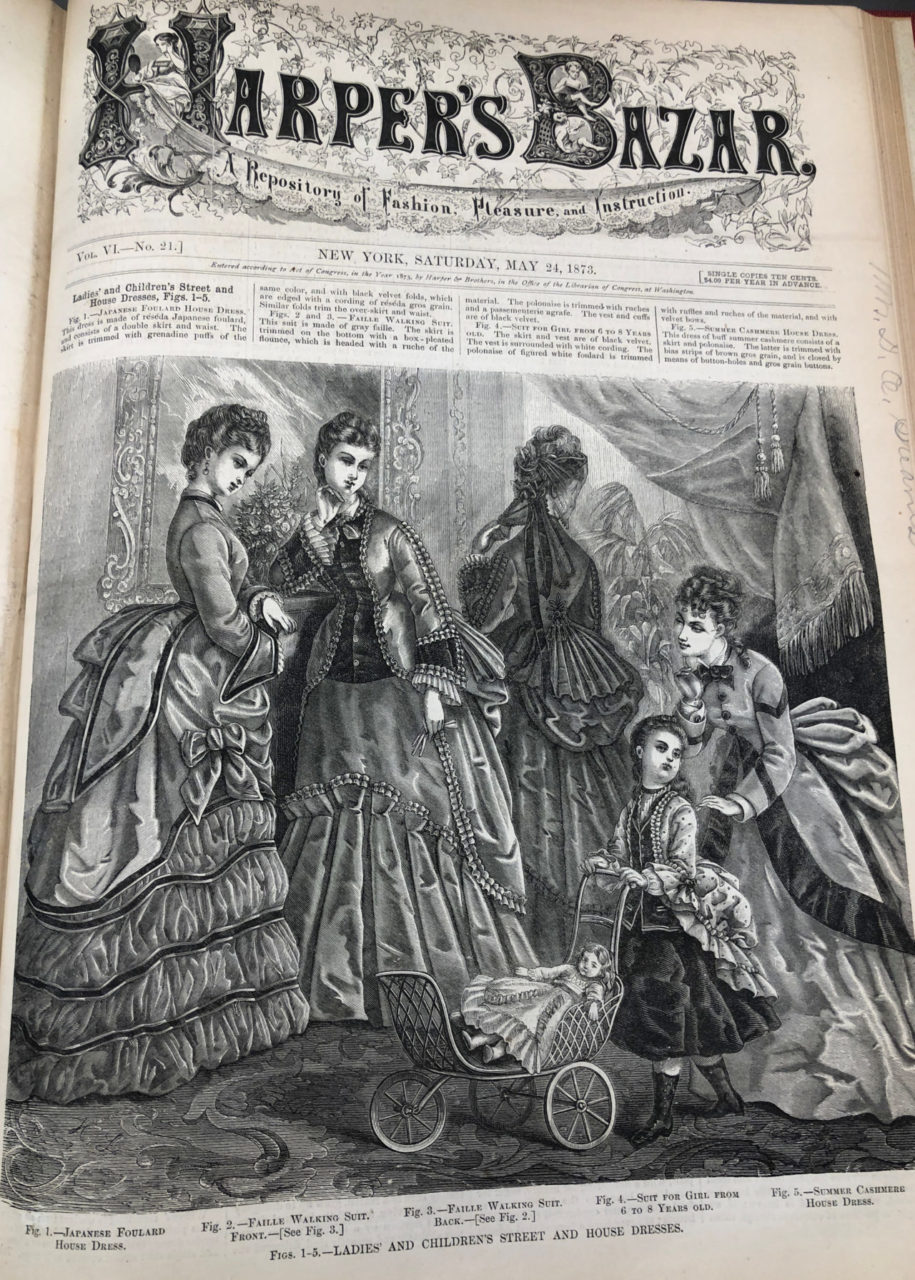Édouard Manet’s Railway depicts modern life in Paris during 1873; he chose to feature his favorite model, Victorine Meurent, assessing the viewer in a simple navy blue twill dress–book in hand and puppy in lap. She is seated alongside a little girl clad in a white springtime dress with an oversized blue sash whose back is turned to the viewer as she’s observing the Gare Saint-Lazare on a warm day.
About the Artwork
Manet entered the studio of Thomas Couture in 1850 where he trained for six years. Early in his career he courted controversy at the Salon with his infamous realist paintings, Luncheon on the Grass, exhibited at the 1863 Salon des refusés, and Olympia, which was exhibited at the official Salon of 1865; both “offered a direct challenge to contemporary conventions for representing the female nude” and “provoked a number of angry comments” (Bomford 202).
In the 1870s Manet became more interested in open-air figure scenes and, as art historian David Bomford notes, “his palette had noticeably brightened in response to the shift in his subject matter and he remained committed to the figure as the chief focus of his work” (203). Manet became “closely associated with the Impressionists” but “did not join their independent group exhibitions and remained committed to showing his work at the Salon” (Bomford 202). This is apparent in The Railway as the setting is en plein air, meaning it is outdoors. The looseness of brushstrokes in this painting is also “a symbol of the modern world” (Pollitt). In fact, The Railway was the only Manet painting accepted by the Salon that year (Cachin 342).
The background of this painting features the Gare Saint-Lazare, which is the largest and busiest train station in Paris, yet it is essentially unrecognizable due to the amount of fog. In the foreground of the painting is a little girl looking down at the tracks and a young woman thought to be her sister or nanny staring out at the viewer. In figure 1, we see a similar en plein air painting by Berthe Morisot that features similar loose brushwork. Eugene Manet with his daughter at Bougival ironically features Manet’s brother, Eugene, calmly sitting on a bench in a garden with his daughter playing with a toy on his lap. Yet, this setting is very idealistic as the sun is shining and the suburban garden is illustrated as a beautiful and serene location. The Railway by Manet, though also en plein air, depicts Paris more as an industrial city.
Fig. 1 - Berthe Morisot (French, 1841-1895). Eugene Manet with his daughter at Bougival, 1881. Oil on canvas; 92 x 73 cm. Paris: Marmottan Monet Museum. Source: Wikiart
Édouard Manet (French, 1832–1883). The Railway, 1873. Oil on canvas; 93.3 x 111.5 cm (36 3/4 x 43 7/8 in.) Washington, DC: National Gallery of Art, 1956.10.1. Gift of Horace Havemeyer in memory of his mother, Louisine W. Havemeyer. Source: National Gallery of Art
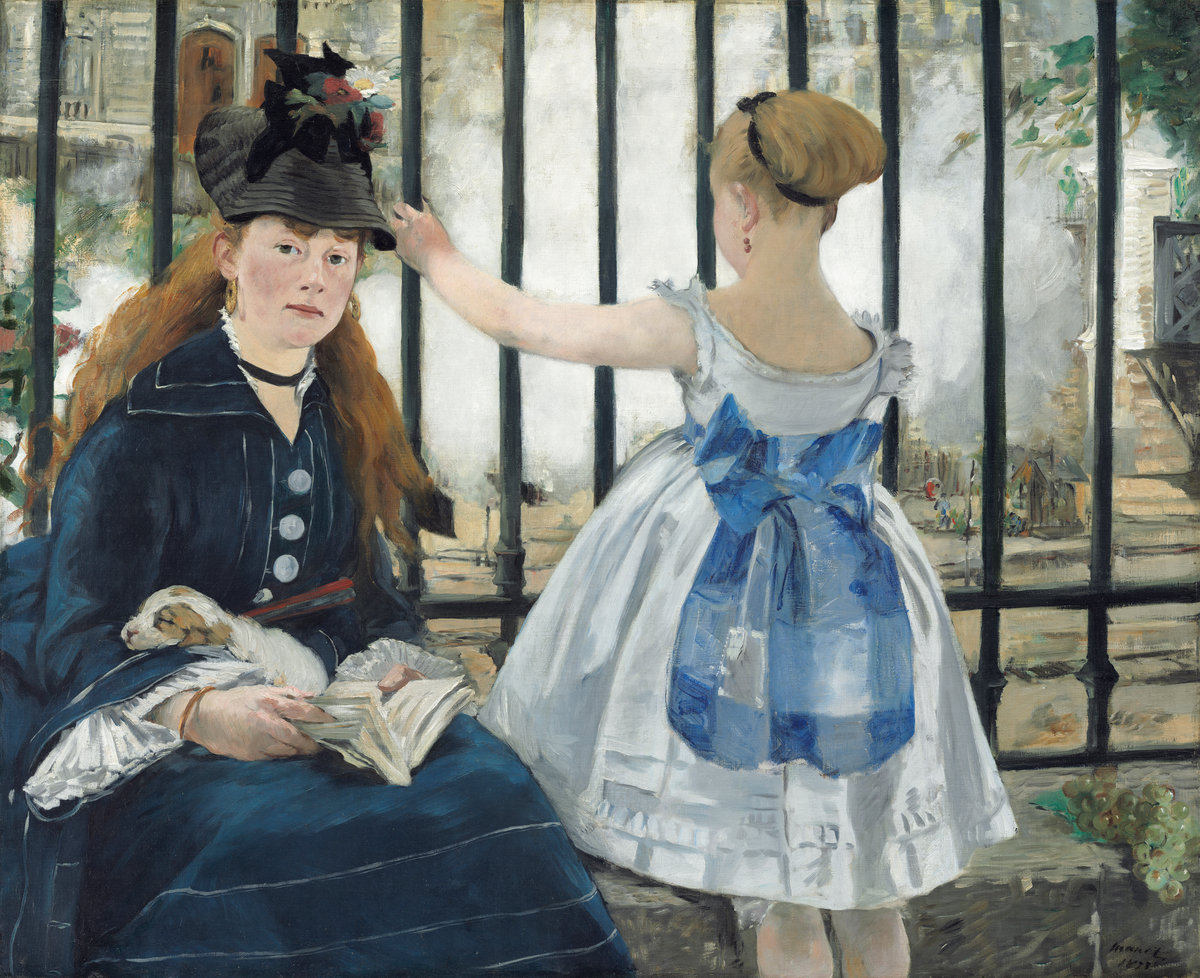
About the Fashion
Manet’s Railway is extremely spatially ambiguous as the artist breaks all rules when it comes to placement of figures and objects. The young girl to the right hand side of the painting has her back turned to the viewer, which rarely happens in Impressionist figure paintings. The other primary figure, Victorine, contrastingly looks out and seems to be assessing the viewer as a way of protecting the little girl. The fact that Victorine’s hair is down and not in an up-do suggests that she is a caretaker or older sister rather than a mother. Also, the inclusion of objects such as the grapes spilling over the ledge are indicative of further collapsing “all of the rules of atmospheric perspective” (Pollitt). Furthermore, the dog appearing on Victorine’s lap is “suggestive of the same dog appearing in Titian’s Venus of Urbino–also the source for Manet’s Olympia“(Cachin 340). Perhaps the dog on Victorine’s lap suggests fidelity, which perpetuates the concept of protection Victorine represents in this painting.
Victorine is one of Manet’s most favored models and she wears what curator Gloria Groom describes as a “splendid blue spring walking dress (perhaps made of twill or light wool), with trend large gold buttons on the bodice, and matching hat” (170). Aside from the context of the painting, the fashion choices of Manet for the two figures are important and suggestive of their lifestyle. The differing ages of the two figures are apparent from their variance in dress as noted by Groom in Impressionism, Fashion and Modernity:
“Manet uses dress to define the different stages of women’s lives. The girl, the child of Manet’s friend Alphonse Hirsch, wears a summery white dress trimmed with lace and a wide blue plaid sash. Her dress has the shorter skirt of childhood, with pantalettes peeking out at her knees. As she grew up, her hem would drop and it would no longer be considered seemly to expose her arms and shoulders, except at the most formal of occasions. Seated next to the young girl, Manet’s favorite model, Victorine Meurent, clearly plays the role of a companion, reserved for youth. The sort of nautical blue dress with minimal white trim that she wears was deemed appropriate for strolling, shopping, and visiting.” (170)
Fig. 2 - Artist unknown. Frank Leslie's Lady's Magazine, vol. 32, no. 1 (1873): 13. Source: Frank Leslie's Lady's Magazine
Fig. 3 - G. Gonin (French). Revue de la mode, no. 23 (1872). Source: Heinrich Heine Universität Düsseldorf
Fig. 4 - G. Gonin (French). Revue de la mode, 1872. Source: Heinrich Heine Universität Düsseldorf
Fig. 5 - Artist unknown. Musée des familles, February 1873. Source: Pinterest
Fig. 6 - Artist unknown (American). Ladies' and Children's Street and House Dresses, May 24, 1873. New York: Harper's Bazar, vol. 6, no. 21. Source: FIT Special Collections
Diagram of referenced dress features.
Source: Michaela Del Viscovo
Both of the figures’ dresses feature a color combination of white and either a navy or pale blue–colors deemed to be fashionable during 1873. In a January 1873 issue of Frank Leslie’s Lady’s Magazine, one of the first engravings of the issue featured is a promenade costume made out of blue silk (Fig. 2). The garment also features a plaited flounce adorned with many bows. Though Victorine’s dress is likely made out of twill or light wool, the fact that this silk blue dress is on the first main page of the issue attests to the color’s fashionability. Figure 3 also features a woman on the right-hand side clad in a dress in two light shades of blue with pleated, fanned-out sleeves similar to Victorine’s in The Railway. Manet cared deeply about fashion and this showed in his paintings. He chose to dress Victorine in a blue suit which “set off the lightweight white summery dress worn by her young companion” (Groom 170). This contrast in color apparent in the figures’ dresses in The Railway is an element of dress during this time according to Frank Leslie’s Lady’s Magazine:
“We have strong contrasts in the depths of colors ; that is to say, dark shades on lighter ones,–for example brown on apricot, mauve or dark lilac on grey,–or else a dark underskirt with a light colored Polonaise.” (121)
Figure 4 shows examples of childrenswear during this time period, and similarly features a child clad in a blue dress similar to the blue found in figure 3. The child in a blue dress in figure 4 is also wearing an oversized bow as a hair accessory reminiscent of the bow the child’s dress in The Railway, which features an oversized bow in the back. Figure 5 features a child’s dress, though in pink, it has a bow on the back evocative of the one on the child’s dress in The Railway. The child’s dress in figure 5 also has a similarly pleated tiers at the bottom of the dress. Aside from the fashion of the children’s dresses in these images, they also both happen to be standing with their arms spread out and open and with their back facing the viewer.
Hair accessories, specifically hats, were popular during this time. In The Railway Victorine is wearing a beautiful black hat adorned with velvet ribbon and artificial flowers. Figure 6 features four women amongst one young child all adorned in dresses with aspects reminiscent of fashion in The Railway. For example, two of the women’s dresses have buttons going down the front like the nanny’s in Manet’s painting. And the woman’s dress to the far left of figure 6 expresses a strong simplicity in addition to the tiers on the dress also similar to the nanny’s. The Railway is safely characteristic of a warm day falling between summer and fall considering the casualness of the figures’ dresses and their apparent relaxedness in spending time sitting on a ledge outside. The child’s dress is seen to be more fashionable than the young woman’s is, though the color of the young woman’s dress is favorable for this time:
“A young woman, wearing the blue twill that was in fashion until the autumn. . . . Motion, sun, clear air, reflections, all give the impression of nature, but nature subtly grasped, and finely rendered.” (Cachin 340)
Victorine’s dress is seemingly more simple and less expensive than the child’s dress. As Victorine appears to be in the role of a caretaker in this painting, it is safe to assume that the figure is not meant to appear to be from a wealthy family. At the same time, however, the young woman is clearly educated as she is reading a book. The color of the young woman’s dress is fashionable, yet the simple style of the dress is not apparent in many fashion plates of this time, and features virtually no characteristics that are innovative for this time other than the pleated sleeves and flowered hat. The young child, on the other hand, likely comes from a family of wealth who has the means to dress their child in a fashionable garment. Manet’s The Railway accurately portrays life in Paris during 1873 and his fashion choices for the figures give a snapshot of class difference in 1870s Paris.
References:
- Bomford, David, ed. Impressionism. London: National Gallery, 1991. http://www.worldcat.org/oclc/232189436.
- Cachin, Françoise, Michel Melot, Charles S. Moffett, and Juliet Wilson Bareau. Manet, 1832-1883. New York: Metropolitan Museum of Art, 1983. http://www.worldcat.org/oclc/718471177.
- Groom, Gloria Lynn, ed. Impressionism, Fashion & Modernity. Chicago: Art Institute of Chicago, 2012. http://www.worldcat.org/oclc/794814340.
- Pollitt, Ben. “Édouard Manet, The Railway – Smarthistory.” Accessed July 12, 2018. https://smarthistory.org/manet-the-railway/.
- “The Railway.” Accessed July 12, 2018. https://www.nga.gov/collection/art-object-page.43624.html.
- The World of Fashion and Continental Feuilletons [Afterw.] The Ladies’ Monthly Magazine, The World of Fashion [Afterw.] Le Monde Élégant; or The World of Fashion, 1873. https://books.google.com/books?id=yxwGAAAAQAAJ.

